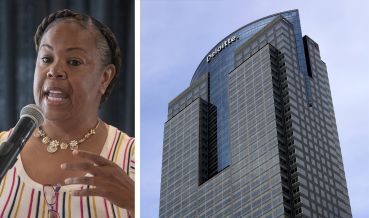NYC’s Commercial Brokers and Owners Look Back on a Terrible 2023
By Rebecca Baird-Remba December 13, 2023 6:00 am
reprints
It hasn’t been an easy year for New York City commercial real estate.
High interest rates, a depressed office market, and a steep decline in investment sales have all made it a challenging year for landlords and brokers, but a somewhat opportune time for office tenants and buyers with cash in hand.
Early in the year, major landlords such as RXR and Brookfield began handing the keys to some of their office buildings back to lenders, in a move that was emblematic of a larger wave of distressed properties and foreclosures in New York and nationwide.
“The office market has been really robust in certain sectors, and that has been at the expense of the bottom third of the market, which is just not functioning at all,” said Mark Weiss, an office leasing broker at Cushman & Wakefield. “All of the discretionary transactions, which include relocations, are migrating to the parts of the market that can function.”
Indeed, the availability rate for Manhattan office buildings remains high, at 17.9 percent in November, compared to 17 percent a year ago and closer to 10 percent pre-pandemic, according to Colliers. As Colliers’ research chief Frank Wallach told Commercial Observer last month, Manhattan office leasing is so far behind where it was last year that another several million square feet of space would need to be leased by year’s end for 2023 to catch up with 2022.
Given that tenants inked about 2.1 million square feet of leases in November — which was an 18 percent monthly drop — it seems unlikely that the year-to-date leasing gap will close. Available sublease space also expanded last month to 20.75 million square feet.
“It doesn’t matter if the bottom portion of the market has a 20 or 30 percent vacancy rate,” Weiss said. “If they can’t perform and stay solvent, people will not stay in those buildings or go to those buildings.”
Weiss felt that the collapse of WeWork — which officially filed for bankruptcy last month after retreating from the market for three years — was a major contributor to the slow-rolling decline of Class B and C office properties in Manhattan.
Tenants want to move to “well-located buildings owned by competent bricks-and-mortar property owners that have amenitized the buildings and improved on the [mechanical] systems,” said Weiss.
Jonathan Kaufman Iger, CEO of owner Sage Realty, admitted that office rents at some of his properties are not where they were in December 2020. The company owns three buildings on Third Avenue in Midtown East — 747, 767 and 777 Third Avenue — where leasing activity has been slow. Sage even renovated 767 Third, revamping the lobby, replacing the mechanical systems, and adding amenity spaces.
“We see demand but not at the level we expected,” Iger said. “We have done a few full-floor deals, but we are leaning more into where we see the demand, which is breaking those floors into smaller suites, from 2,000 to 4,000 square feet.” Smaller prebuilt suites — especially those with higher-end finishes — seem to be leasing more quickly, he said.
The firm is also renovating a Financial District office tower at 77 Water Street, but leasing in the area has been so slow that Sage is considering an office-to-residential conversion for the property.
The investment sales market hasn’t been pretty, either. Transaction volume this year has been down for every asset class in the five boroughs, with office taking the biggest hit. Sales of office buildings slid from $2.8 billion in the third quarter of 2022 to just $252 million — and eight transactions — in the third quarter of 2023, according to third-quarter data from JLL.
Similarly, there were only 13 multifamily trades, totaling $797 million, in the third quarter of this year, down from 42 sales for $2.7 billion during the same period last year. Even industrial sales have been sluggish, at nine sales totaling $264 million for the third quarter of 2023, compared to 43 trades for $1.2 billion a year ago.
Fundamentally, many commercial landlords are overleveraged, or have loans coming due and are unable to refinance their properties with interest rates floating between 7 and 8 percent. Owners stuck in untenable positions either end up handing back keys — which their lenders don’t want — or trying to get out from under their debt by filing for bankruptcy.
“A lot of folks and owners want to sell but they can’t, because their exit strategy doesn’t take them out of their [financial] obligations,” said Adelaide Polsinelli, an investment sales broker at Compass. “The options become slim. Do you hand back the keys or hope that the market turns in the next two, three, five years? Interest rates come down, and office tenants come back, or there’s some savior buyer out there that has to have that building and will buy it at a premium?”
These trends hold true even in the more affordable parts of the city. Stephen Preuss, an investment sales broker at Ripco who sells development sites and mixed-use properties in the outer boroughs, said that “there are an inordinate amount of headwinds in the market right now. This is unlike many of the other downturns that I’ve seen in the last 20 years. Most people that are still active have access to funds and still have banking relationships with a little more expensive debt.”
Preuss noted that most people buying right now are local, longtime owners who have established ties with local banks, because institutional buyers are too skittish or unable to get financing. And most recent sales have involved smaller properties that are easier to buy with cash.
“Ninety percent of everything that’s traded in New York City this year is under $10 million,” said Preuss. “That price point appeals more to family office or local owners who might have been priced out in the last cycle or two.”
He added that “a lot of the larger product isn’t selling. The higher-net-worth groups are taking a conservative approach, and there’s not a lot of lenders that are looking to lend $50 or $100 million on a transaction.”
On the investor side, many people are waiting for lenders to start selling distressed properties or their debt next year — potentially at a big discount. The larger commercial real estate world also has a close eye on whether interest rates will stabilize or even decline next year, after Federal Reserve Chairman Jerome Powell signaled earlier this month that the central bank might be done raising interest rates.
“I think the note sale market will get more aggressive in the first quarter of next year,” said Polsinielli. “Then there will be repositioning of those assets — do investors stabilize or do they turn around and flip them? If interest rates come down, then they turn around and flip it. A lot of these funds buy for three- to five-year holds, and by then we’ll be out of the interest rate spiral and land on something a little more firm.”
Preuss said he believes that the wave of distressed sales might arrive later in the year, but that the number of investment sales will definitely tick up.
“I think the worst of the paralysis is behind us,” he said. “I think there will be more activity next year but it will be what I consider a reckoning — the forbearance, the defaults. The can has been kicked down the street. A lot of that will start to come to market — distressed activity, lenders getting properties off their books.”
The presidential election could also be a complicating factor in the commercial leasing and investment sales market.
“I think next year is going to be a scary year,” said Weiss. “Leasing will slow down next year dramatically. Presidential election years are usually fraught with hesitation and concern. Lots of discretionary transactions don’t happen in election years.”
The sales of multifamily residential buildings and development sites have also struggled, despite New York apartment rents hitting a record high this year. Rents appear to have peaked in August, with the average monthly Manhattan rent ticking up to $5,552, according to brokerage Douglas Elliman and appraiser Miller Samuel. The 421a tax exemption, which helped prop up multifamily development in New York, expired in mid-2022, essentially forcing developers to hit pause on new residential development in most of the city. The state legislature has yet to agree on a replacement.
“With the lack of 421a, it is nearly impossible to build rental residential development,” said Preuss. “That market has completely stalled. We’ve seen a flight towards condo development sites” particularly in pricier residential neighborhoods like Long Island City, Queens, and Greenpoint and Williamsburg, Brooklyn.
And the 2019 tenant-friendly rent law changes have dampened the value of rent-
stabilized buildings because owners have few avenues to raise rents significantly or deregulate units. Landlords of rent-regulated properties “are frustrated with where the legislation is going,” said the broker. “The value is eroding. There will be some sort of threshold point because the bricks are getting so cheap. It’s happening, but I wouldn’t be surprised if some of that gets given back to the bank. There aren’t any green shoots or ability to add value to these buildings.”
Many of those owners also relied on mortgages from Signature Bank, which state regulators shut down in March. Now $33 billion worth of those loans are on the auction block — and for much less than they’re worth. Related Companies reportedly bid 69 cents on the dollar in November for a 5 percent stake in $6 billion worth of rent-stabilized loans, causing even more concern among existing owners and lenders in rent-regulated properties, who are hoping to maintain their current property values.
Developers feel exactly the same way about 421a.
“So, to start a new project right now without 421a, it’s a condo — you cannot make a rental work,” said Hal Fetner, CEO of Fetner Properties, which has 850 units under construction in New York.
Higher borrowing costs, too, meant relying on different financing sources. Fetner, for one, approached Brookfield in 2023 for private debt. Fetner had never done private debt before. The cost of materials and labor also continued to go up and down in 2023. And, while rents rose, that was a two-way street for builders, including in New York.
“My investors are thrilled right now that there’s no new 421a because it sort of solidifies, hopefully, our success,” Fetner said. “As a New Yorker, you should be incensed that there’s no new housing coming on the market.”
For owners who are focused more on leasing than construction, business has been booming. “Demand for rental housing appears to be really strong right now,” said Donald Capoccia, managing partner at BFC Partners, a developer and owner. He cited a fast lease-up of 164 units in 2023 at his firm’s redevelopment of the old Bedford Union Armory in Crown Heights, Brooklyn, as proof.
BFC Partners’ sales of apartments at its Essex Crossing project on Manhattan’s Lower East Side — that’s a different story. Sales have been slower there in the midst of a decline in higher-end condo transactions, largely thanks to this year’s spike in interest rates. Nine units remain out of 83 at that project, and the majority went in 2022. “I think we’re in a good place there, but it would have been much better if we had gotten out of that in 2023,” Capoccia said of selling all the units.
For soundstages, a once-hot niche asset class, 2023 will be remembered for a severe slowdown in demand. The reason? Months-long strikes by Hollywood writers and actors that were only resolved this fall.
“Everybody wants to get into the soundstage business only because they know nothing about it,” Doug Steiner, a developer and the chairman of Steiner Studios in the Brooklyn Navy Yard, said. “Hollywood is very seductive.”
Steiner said that soundstages such as his seemed like a solid investment early on in the pandemic as COVID-19 disrupted so many asset classes. Investors and builders poured in. The niche then reaped a whirlwind this year as the strikes ground production to a halt. (What’s more, as Steiner noted, soundstages aren’t exactly a prime conversion candidate — they can really serve only their one purpose unlike offices, warehouses, and other vacant shells.)
Brick-and-mortar retail, on the other hand, has been a — surprisingly — bright spot this year.
“Retail seems to be in a strong place compared to the other legs of the stool,” said retail leasing broker Steve Soutendijk of Cushman & Wakefield. “The stats show a healthier market than we’ve had. The dirty secret is that the retail market wasn’t that great in 2019 or 2020 before COVID. It’s the healthiest market we’ve had since 2013 or 2014.”
There are fewer vacant storefronts than there were a year or two ago in almost every submarket Cushman tracks, including SoHo, which struggled with high rents and high vacancy in 2019. Fifth Avenue in Midtown had many of the same issues — vacancy combined with extremely high rents — but the high-end retail corridor has started to turn around.
Soutendijk pointed to his own deals with Hoka at 579 Fifth Avenue and a “big multinational apparel brand” at 575 Fifth Avenue, along with a lease for Burberry at 693 Fifth and a renewal for Barnes & Noble. Herald Square, meanwhile, is the outlier, with 40 percent vacancy. Victoria’s Secret, Gap and Banana Republic all shuttered large stores in the area during the pandemic, and Hooters vacated a 7,000-square-foot space on the corner of West 33rd Street and Seventh Avenue.
Ultimately, Soutendijk blamed the office market’s struggles for some of the glaring retail vacancy in Manhattan.
“When I’m talking about taking bigger spaces and dividing them up, that takes capital,” said Soutendjik. “When you’re on the bottom of an office building that has a loan coming due and the bank doesn’t want to refinance, you might not be able to pull out the capital required to improve it or split it up. We’ll see that and continue to see that in 2024.”
He added that cash-strapped owners might be less willing to do tenant improvements for retail spaces, particularly for restaurants that often require new gas or water lines or additional ventilation for stoves.
“If you’re a Garment Center building and you’ve got a loan coming due,” said Soutendjik, “the economics of that have become challenging even though the demand is there.”


